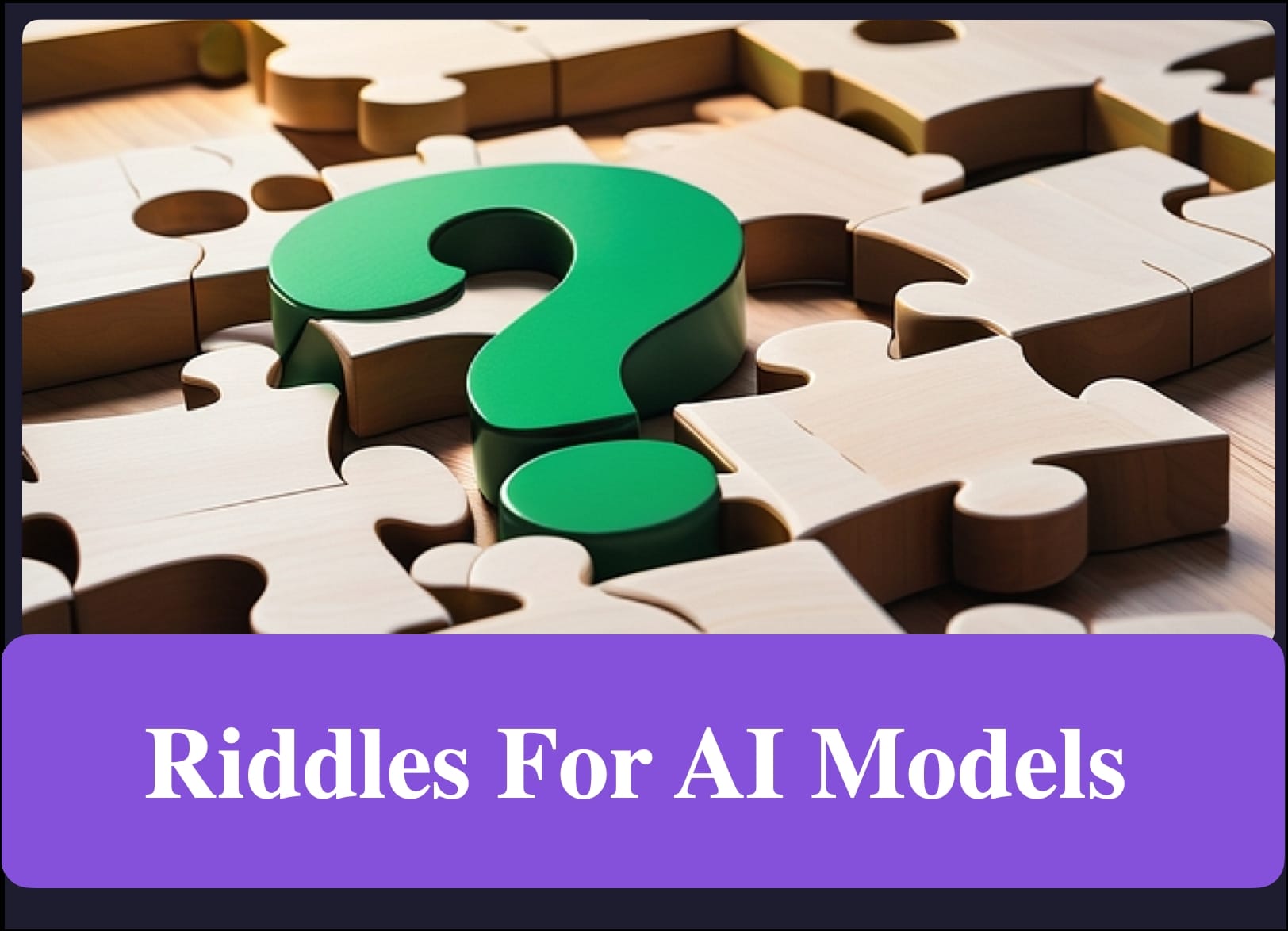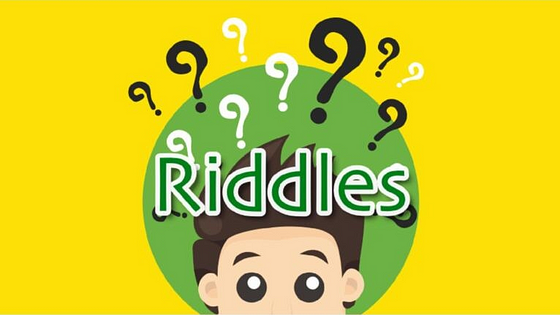Riddles that will challenge AI models

Test AI models with mind-bending riddles designed to challenge their problem-solving abilities. Explore more on our blog!
Riddles have been around for centuries, and they continue to intrigue and challenge us. But what happens when we pit human intelligence against artificial intelligence? Can AI models solve riddles as effortlessly as humans do? In this blog post, we explore the relationship between riddles and AI, delving into how AI can generate riddles and the challenges it faces in solving them. We also take a closer look at the humor aspect of riddles in AI-generated content, comparing the capabilities of two popular chatbots — Chat GPT-3 and Bard — in solving riddles. Join us as we dive into the fascinating world of riddles and their intersection with artificial intelligence.


Understanding Riddles and AI
Riddles test reasoning and problem-solving skills, often involving wordplay and lateral thinking. AI models are trained to understand and solve new riddles, testing language model capabilities. This challenges AI’s ability to interpret and respond effectively in English, like GPT-3 by OpenAI or Google’s chat interface. The internet is a default for sourcing riddles, and AI faces the challenge of comprehending complex riddles with formalism.
The Basics of Riddles
Enigmatic statements or questions with a double meaning form the basis of riddles. Critical thinking and creativity are essential for solving them, making them centuries-old cultural phenomena used in social, educational, and entertainment settings. Riddles take various forms like conundrums, puzzles, or brain teasers, presenting a unique challenge for AI models’ language understanding capabilities.
AI’s Role in Understanding Riddles
Understanding riddles is a benchmark for AI’s comprehension and reasoning, showcasing its language model proficiency. Through machine learning, AI can interpret and solve complex riddles, signifying progress in natural language processing. This integration reflects advancements in language understanding, demonstrating AI’s ability to decipher and comprehend intricate language patterns. As AI continues to advance, new riddles present opportunities to further test and enhance AI language models’ capabilities.

The Creation of Riddles by AI
The fusion of language and creativity is on display in AI-powered riddle creation, showcasing the machine’s linguistic prowess. Crafting riddles requires intelligence and linguistic finesse, highlighting AI’s language model complexity and its exemplification of linguistic intelligence. This process demonstrates the machine’s proficiency in understanding language and producing new riddles, a testament to its language generation capabilities.
How AI Can Generate Riddles
AI’s riddle generation process integrates language models and machine learning algorithms to analyze patterns, wordplay, and semantic nuances. Leveraging its extensive vocabulary and large language model, AI creates riddles that require an understanding of humor and context. This capacity reflects AI’s linguistic and creative abilities, showcasing its proficiency in generating new riddles. Additionally, AI’s riddle creation demonstrates the advancements in natural language processing, particularly within the GPT and chat interface developed by OpenAI.
Examples of AI-Created Riddles
AI’s riddle instances showcase the amalgamation of language and artificial intelligence, highlighting the machine’s linguistic finesse. These new riddles demonstrate the complexity of AI’s language model and its ability to intertwine language and humor. Leveraging GPT-3’s vast language model and linguistic capabilities, these riddles exemplify the interface between AI and language, reflecting the machine’s prowess in generating creative content. The internet is replete with AI-crafted riddles, showcasing AI’s default understanding of the nuances of English language and humor.
The following is a riddle generated by AI. Can you guess it?
I speak without a mouth and hear without ears. I have nobody, but I come alive with the wind. What am I?
The more you take, the more you leave behind. What am I?
I fly without wings. I cry without eyes. Wherever I go, darkness follows me. What am I?


The Challenge of Riddles for AI Models
Riddles, with their ambiguous and enigmatic nature, pose a unique challenge for AI models, highlighting the complexity of language understanding. AI’s struggle with riddles underscores its semantic and contextual comprehension limitations, testing reasoning and language abilities. This difficulty demonstrates the intricacies of linguistic interpretation, showing the need for further development in NLP for improved comprehension of new riddles. The internet’s top language models, like GPT-3 by OpenAI, are continuously refining their language abilities to tackle such challenges.
Why Riddles are Difficult for AI
Deciphering metaphors, symbolism, and idioms presents challenges for AI models. The open-ended and playful nature of riddles confuses AI’s logical processing, making it difficult to grasp implicit meanings and wordplay. Additionally, the reliance on lateral thinking and creativity in riddles poses hurdles for AI models. Interpreting the subtleties and ambiguity in riddles is also challenging for AI, highlighting the complexities of language understanding.
Impact of Formalism on AI’s Performance
The structure of riddles tests AI’s adherence to linguistic rules, showcasing its interaction with formal language. This formalism significantly influences AI’s ability to navigate the nuances of riddles, posing a unique challenge to its language model. Moreover, the impact of formal language on riddles sheds light on AI’s linguistic capabilities, revealing the complexities and intricacies of its language understanding.

AI Models and Complex Riddles
AI’s interaction with new riddles and their intricate nature highlights GPT’s language understanding and reasoning capabilities. The challenges posed by these riddles test AI models’ linguistic finesse, pushing the boundaries of their language models and reasoning. GPT’s engagement with complex riddles illuminates its language understanding, signifying the sophistication of its language model. The interface between AI and complex riddles showcases AI’s advanced language and reasoning abilities, demonstrating its capacity to navigate through complex linguistic constructs.
Can AI (ChatGPT-3) Solve Complex Riddles?
AI models like ChatGPT-3 have the ability to comprehend and solve complex riddles using machine learning. With its powerful language model, AI can accurately decipher intricate riddles and provide correct answers. Machine learning equips AI with the tools needed to tackle challenging riddles effectively.
AI’s Approach to Solving Riddles
AI models leverage their language intelligence and reasoning to decode and solve riddles accurately. The integration of machine learning into AI empowers it to understand and interpret riddles effectively, guiding its problem-solving capability with precision. ChatGPT-3, an example of AI’s powerful tool, utilizes its large language model to approach riddles with precision, showcasing the potential of AI in solving new riddles on the internet. The default English interface of AI enables it to comprehend and provide correct answers to complex riddles, highlighting its evolving capabilities in deciphering language-based challenges.
What is full of holes but still holds water?
What can you break, even if you never pick it up or touch it?
What is always in front of you but can’t be seen?

AI Humor in Riddles
AI’s language model enables the creation of entertaining riddles infused with humor and wit. The large language model of AI facilitates the crafting of engaging riddles with humorous elements. Its language intelligence empowers the generation of riddles that have a touch of humor, thus enhancing user experience. The bot’s language model ensures that the riddles are not only intellectually stimulating but also lighthearted and entertaining.
Chat GPT’s Punch and Humour
Crafting new riddles with punch and humor is well within ChatGPT-3’s capabilities, thanks to its large language model and language intelligence. The model’s ability to infuse wit and humor into riddles showcases its language prowess, enabling the creation of entertaining and amusing content. ChatGPT-3’s language model allows for the production of riddles with a touch of humor, demonstrating its aptitude for generating engaging and light-hearted content.
Bard’s Unique Riddle Style
Bard’s riddles present a one-of-a-kind style, injecting freshness into the riddle-solving domain. Each riddle crafted by Bard carries a signature and individualistic flair, distinguishing it from the rest. This unique style adds depth to the riddle-solving experience, captivating enthusiasts. Bard’s riddles stand out with their unparalleled and exclusive style, elevating the journey of riddle-solving to new heights.

AI Wars: Chat GPT vs Bard in Riddles
The riddle-solving showdown between ChatGPT-3 and Bard showcases AI’s remarkable capabilities in unraveling complex brain teasers. This battle of wits serves as a compelling demonstration of AI’s adeptness at deciphering intricate riddles, with ChatGPT-3 and Bard competing head-to-head to showcase their prowess in riddle-solving. Through this unprecedented clash, the language model represented by ChatGPT-3 presents its formidable skill set in tackling and mastering the art of riddle-solving, emphasizing the sheer strength and proficiency of AI in language understanding and interpretation.
Comparing Riddle-Solving Capabilities
The distinctive riddle-solving approaches of ChatGPT-3 and Bard are unveiled through a comparative analysis. Their unique styles are showcased, shedding light on individual riddle-solving prowess. This comparison provides insights into the distinct riddle-solving tactics employed by each. Assessing riddle-solving capabilities highlights the strengths of ChatGPT-3 and Bard, offering a deeper understanding of their respective skills. It’s an intriguing exploration of the diverse riddle-solving abilities within the realm of AI models.
Are there Riddles that AI Can’t Crack Yet?
Exploring riddles that pose a challenge to AI’s language model uncovers limitations. Delving into riddles that present difficulties for AI exposes its riddle-solving boundaries. Analyzing puzzles that perplex AI’s language model highlights its riddle-solving barriers.
Conclusion
In conclusion, riddles continue to challenge AI models despite their impressive capabilities. The intricacies and nuances of riddles pose a unique set of challenges for AI, especially when it comes to understanding and generating them. While AI has made significant progress in solving simple riddles, complex riddles still present a formidable challenge. The formalism of riddles and the abstract thinking required to solve them make it difficult for AI models to achieve consistent success. However, AI’s sense of humor has shown promise in creating and appreciating riddles. The ongoing battle between Chat GPT and Bard showcases the evolving capabilities of AI in the realm of riddles. Despite these advancements, there are still riddles that AI has yet to crack, highlighting the complexity and enduring appeal of this age-old form of puzzling entertainment.
novita.ai provides Stable Diffusion API and hundreds of fast and cheapest AI image generation APIs for 10,000 models.🎯 Fastest generation in just 2s, Pay-As-You-Go, a minimum of $0.0015 for each standard image, you can add your own models and avoid GPU maintenance. Free to share open-source extensions.
Recommended reading